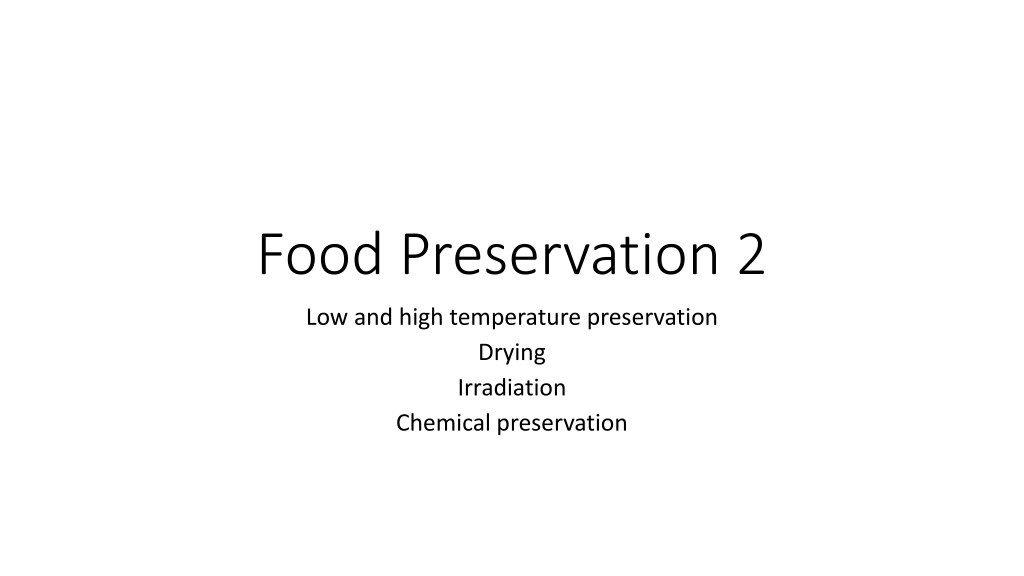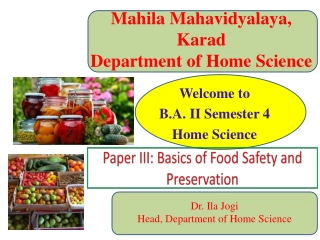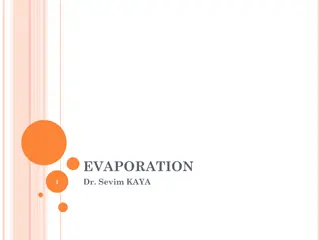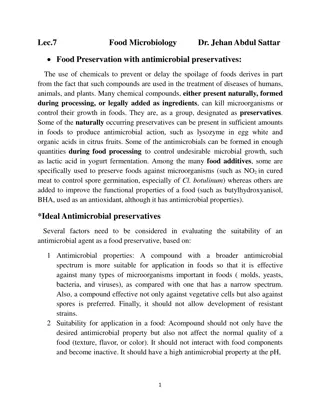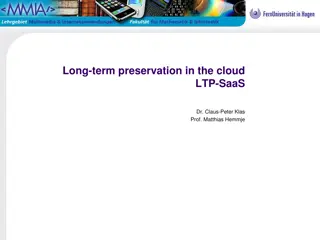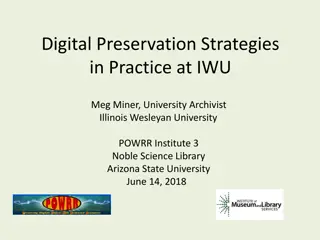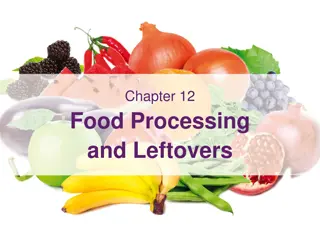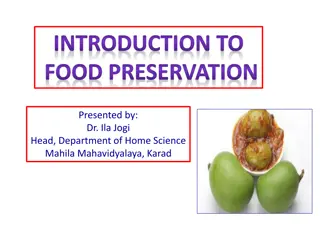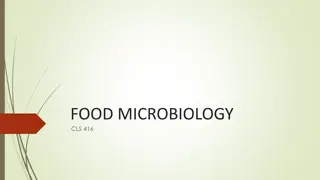Understanding Blanching: A Key Step in Food Preservation
Blanching is a crucial pre-treatment process for vegetables and fruits in food preservation methods like canning, freezing, and dehydration. By rapidly heating the food and then cooling it, blanching helps inactivating enzymes, removing gases, brightening colors, and improving texture. This process also serves as a cleaning and decontamination step, reducing pesticide residues and harmful microorganisms on the surface of produce.
Download Presentation

Please find below an Image/Link to download the presentation.
The content on the website is provided AS IS for your information and personal use only. It may not be sold, licensed, or shared on other websites without obtaining consent from the author. Download presentation by click this link. If you encounter any issues during the download, it is possible that the publisher has removed the file from their server.
E N D
Presentation Transcript
Food Preservation 2 Low and high temperature preservation Drying Irradiation Chemical preservation
Preservation by heat treatment Blanching Sterilization Pasteurization
Blanching Most vegetables and some fruits are blanched prior to further processing operations, such as canning, freezing or dehydration. Blanching is a mild heat treatment, but is not a method of preservation per se. It is a pretreatment usually performed between preparation and subsequent processing. Blanching consists of heating the food rapidly to a predetermined temperature, holding for a specified time, then either cooling rapidly or passing immediately to the next processing stage.
Mechanism of Blanching Plant cells are discrete membrane-bound structures contained within semirigid cell walls. The outer or cytoplasmic membrane acts as a skin, maintaining turgor pressure within the cell. Loss of turgor pressure leads to softening of the tissue. Within the cell are a number of organelles, including the nucleus, vacuole, chloroplasts, chromoplasts and mitochondria. This compartmentalization is essential to the various biochemical and physical functions. Blanching causes cell death and physical and metabolic chaos within the cells. The heating effect leads to enzyme destruction as well as damage to the cytoplasmic and other membranes, which become permeable to water and solutes. An immediate effect is the loss of turgor pressure. Water and solutes may pass into and out of the cells, a major consequence being nutrient loss from the tissue. Also cell constituents, which had previously been compartmentalized in subcellular organelles, become free to move and interact within the cell.
Blanching-Purpose The major purpose of blanching is frequently to inactivate enzymes, which would otherwise lead to quality reduction in the processed product. Such quality-changing enzymes, that is enzymes which will give rise to loss of colour or texture, production of off odours and flavours or breakdown of nutrients include a range of peroxidases, catalases and lipoxygenases. Blanching causes the removal of gases from plant tissues, especially intercellular gas. This is especially useful prior to canning where blanching helps achieve vacua in the containers, preventing expansion of air during processing and hence reducing strain on the containers and the risk of misshapen cans and/or faulty seams. In addition, removing oxygen is useful in avoiding oxidation of the product and corrosion of the can. Removal of gases, along with the removal of surface dust, has a further effect in brightening the colour of some products, especially green vegetables. Shrinking and softening of the tissue is a further consequence of blanching. This is of benefit in terms of achieving filled weight into containers. It may also facilitate the filling of containers. A further benefit is that blanching acts as a final cleaning and decontamination process, which helps to remove pesticide residues or radionuclides from the surface of vegetables, spoilage or pathogenic microorganisms, while toxic constituents naturally present (such as nitrites, nitrates and oxalate) are reduced by leaching.
Considerations during Blanching The following factors must be considered: fruit or vegetable properties, especially thermal conductivity, which will be determined by type, cultivar, degree of maturity etc.; overall blanching effect required for the processed product, which could be expressed in many ways including: achieving a specified central temperature, achieving a specified level of peroxidase inactivation, retaining a specified proportion of vitamin C; size and shape of food pieces; method of heating and temperature of blanching medium. Time/temperature combinations vary very widely for different foods and different processes and must be determined specifically for any situation. Holding times of 1 15 min at 70 100 C are normal.
Types of blanching methods The two main approaches in commercial practice are to convey the food through 1. saturated steam or 2. hot water. 3. Microwave blanching has been demonstrated on an experimental scale but is too costly at present for commercial use.1. Steam Blanching Conventional steam blanching consists of conveying the material through an atmosphere of steam in a tunnel on a mesh belt. Uniformity of heating is often poor where food is unevenly distributed The cleaning effect on the food is limited. However, the volumes of wastewater are much lower than for water blanching. 2. Hot water Blanching Cleaning of the food material is better achieved There is uniformity of heating Large volumes of waste water are generated Cooling may be with water or air. Water cooling may increase leaching losses but the product may also absorb water, leading to a net weight gain. Air cooling leads to weight loss by evaporation but may be better in terms of nutrient retention.
Pasteurization Pasteurization is a mild heat treatment (usually below 100 C), which is used on a wide range of different types of food products. Pasteurization is a process applied to a product with the objective of minimizing possible health hazards arising from pathogenic microorganisms associated with the product (milk) which is consistent with minimal chemical, physical and organoleptic changes in the product . This definition is also applicable to products other than milk, including, creams, ice cream mix, eggs, fruit juices, fermented products, soups and other beverages. The two primary aims of pasteurization are: 1. To remove pathogenic bacteria from foods, thereby preventing disease 2. To remove spoilage (souring) bacteria to improve its keeping quality.
Pasteurization does not inactivate all microorganisms Pasteurization includes : The Holder process at 63 C for 30 min, HTST processes 72 C for 15 secs .UHTST process- 150 C for 1 sec
Irradiation Principles of Irradiation Irradiation literally means exposure to radiation. In practice, three types of radiation may be used for food preservation: Gamma rays, X-rays or high-energy electron beams. These are termed ionizing radiations. Although the equipment and properties differ, the three radiation types are all capable of producing ionization and excitation of the atoms in the target material, but their energy is limited so that they do not interact with the nuclei to induce radioactivity. Gamma rays and X-rays are part of the electromagnetic spectrum, and are identical in their physical properties, although they differ in origin. Two basic purposes can be achieved by food irradiation: 1.extension of storage life 2. prevention of foodborne illness.
Radiation treatments aimed at the inactivation of microorganisms are conveniently classified as: Radappertization: a treatment which aims to reduce the number and/or activity of microorganisms to such a level that they are undetectable. Properly packaged radappertized foods should keep indefinitely, without refrigeration. Doses in the range 25 50 kGy are normally required. Radicidation: this aims to reduce the number of viable spore-forming pathogenic bacteria to an undetectable level. Doses of 2 8 kGy are normally required. Radurization: a treatment sufficient to enhance the keeping quality of foods through a substantial reduction in the numbers of viable specific spoilage organisms. Doses vary with the type of food and level of contamination, but are often in the range 1 5 kGy.
Applications of irradiation Inhibition of Sprouting The shelf life of tuber and bulb crops, such as potatoes, yams, garlic and onions, may be extended by irradiation at low dose levels by preventing sprouting. Delay of Ripening and Senescence Living fruits and vegetables may be irradiated to extend shelf life by delaying the physiological and biochemical processes leading to ripening. Insect Disinfestation Insects can cause damage to food as well as leading to consumer objections. Fortunately insects are sensitive to irradiation and can be controlled by doses of 0.1 1.0 kGy. These doses may not necessarily cause immediate lethality, but will effectively stop reproduction and egg development
Elimination of Parasites Relatively few foodborne parasites afflict humans. The two major groups are single-celled protozoa and intestinal worms (helminths) which can occur in meats, fish, fruit and vegetables. Irradiation treatment is feasible although not widespread. Miscellaneous Effects on Food Properties and Processing Although chemical changes to food resulting from irradiation are very limited, it is possible that irradiation could produce beneficial changes to the eating or processing quality of certain foods. Chemical changes could result in textural changes in the food. The most likely examples are depolymerization of macromolecules such as starch, which could lead to altered baking performance or changes in drying characteristics. Irradiation may cause cellular injury in some fruits, giving rise to easier release of cell contents and hence increased juice recovery from berry fruits.
Impact on food quality Vitamin losses as a result of irradiation are generally quite small. Vitamin losses as a result of irradiation depend upon a number of factors including the radiation dose, the oxygen partial pressure and the composition of the food. In some cases vitamin levels in food have been found to increase following irradiation. While irradiation can cause denaturation of proteins, changes in functionality and destruction of amino acids at high doses, the changes are negligible at the doses employed in commercial food irradiation facilities. The irradiation of milk, even at very low levels, e.g. 0.5 kGy, can result in the production of off-flavours. For this reason the irradiation of dairy products is not generally recommended.
Sulphiting Sulphur dioxide (SO2) or inorganic sulphites (SO32-) may be added to foods to 1. control enzymic and non-enzymic browning, 2. to control microbial growth, or 3. As bleaching or reducing agents or antioxidants. The main applications are preserving or preventing discoluration of fruit and vegetables. The following sulphiting agents are permitted by European law: sulphur dioxide, sodium sulphite, sodium hydrogen sulphite, sodium metabisulphite, potassium metabisulphite, calcium sulphite, calcium hydrogen sulphite and potassium hydrogen sulphite. Sulphites may be used to inhibit and control microorganisms in fresh fruit and fruits used in the manufacture of jam, juice or wine. In general, the antimicrobial action follows the order: Gram negative bacteria>Gram positive bacteria > moulds > yeasts.
However, sulphites have some disadvantages: 1. It has dangerous side effects for asthmatics; and their use has been partly restricted by the US Food and Drug Administration. 2. Sulphites react with many food components, including aldehydes, ketones, reducing sugars, proteins and amino acids, to form a range of organic sulphites. Some of the reactions lead to undesirable consequences, in particular leading to vitamin breakdown.
A more widespread application is the inhibition of both enzymic and non-enzymic browning. In addition, sulphites bind reducing sugars, which are necessary for non-enzymic browning, and inhibit oxidative enzymes including polyphenoloxidase, which are responsible for enzymic browning. Sulphiting has commonly been used to prevent enzymic browning of many fruits and vegetables, including peeled or sliced apple and potato, mushrooms for processing, grapes and salad vegetables.
